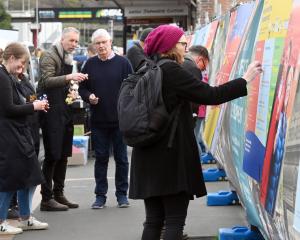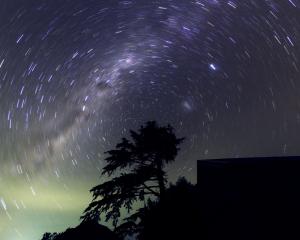
"Space: the final frontier," William Shatner intoned as the opening credits rolled on the time- and space-bending TV series Star Trek that first screened 50 years ago this week.
What followed were hour-long flights of fancy as science fiction played out across strange new worlds, Day-Glo landscapes of polystyrene boulders.
Albert Einstein, he of space and time, might well have approved.
He said: "Imagination is more important than knowledge. For knowledge is limited, whereas imagination embraces the entire world, stimulating progress, giving birth to evolution."
Captain James T. Kirk could hardly have put it better.
In the tradition of the former, and perhaps even the latter, the latest in Dunedin’s art and science series of exhibitions opens on Friday, in what is now a four-year mission to explore the possible intersections between the two.

This year it is "Art and Space", following on from, in chronological order, "Art and Neuroscience" (2013), "Art and Anatomy" (2014), and last year’s "Art and Light".
The series was initiated by Dr Ruth Napper, from the University of Otago’s department of anatomy, who together with Peter Stupples, one-time art history professor at Otago and now a senior lecturer at the Dunedin School of Art, help scientists and artists to reach across the space between them so they might work collaboratively on projects around the theme of the year.
Stupples says this year’s theme was inspired by Otago Museum’s planetarium.
"That gave us the lead-in to work with this idea of space," he says.
"It’s about space but it’s also about the interaction between artists and scientists."
Einstein was another inspiration, as it was the 100th anniversary of his general theory of relativity just last year.
Artists involved are mostly staff, students or graduates of the Dunedin School of Art, but not exclusively.
Some are back for their third project.
Scientists are drawn from across the university.
Each year the process is the same.
All gather, scientists and artists, for the scientists to make presentations on their areas of research.
Over subsequent sessions, the artists talk about their work.
Then the "magic" happens, Stupples says.
"The magic — we don’t quite know how that works — is to actually fix up an artist with a scientist, or a group of artists with a group of scientists.‘‘In the end we do get this matching, which we have done successfully again this year."
That was all eight months ago, since when the work that will be unveiled in the exhibition has been taking shape.
In the end, 16 artists have stayed the course, allied to about the same number of scientists.
Space, which began as the great beyond, has become all sorts of other things in the hands of the artists, as you might expect.
Einstein and his theories on space and time are central to several of the works.
But not to others.
Imagination has been a factor.
As the great scientist himself said, finishing the quote above: "It is strictly speaking, a real factor in scientific research".
"It rapidly became quite clear that many people, many scientists are working on other sorts of spaces, like minute spaces," Stupples says.
In her research, neuroscientist Dr Napper, for example, has been thinking about what happens to the spaces left vacant when alcohol destroys brain cells.
So that’s a minute space.
"Some artists are interested in that sort of thing," Stupples explains.
• Artist Esther Ritter took up the idea in mixed media on canvas.
"The other sort of space we conceived of quite late in the piece really was what I call social space," Stupples says.
Artist Aroha Novak jumped on that to expand on the work she has been doing around the old Carisbrook site: "The Brook Project".
Together with Stupples, they investigated the ground’s past as a public space and questioned its future, as it moves from one sort of space, in time, to another.
"So outer space, inner space and social space became part and parcel of what we were doing in the end," Stupples says of the exhibition.
There is a significant Maori presence this year.
Artist Heramaahina Eketone, in a collaboration with Otago Museum director Ian Griffin — and picking up on the work of University of Waikato lecturer Dr Rangi Matamua in the areas of cosmology, astrological navigation and meteorological science, in particular associated with Tuhoe — has produced a sculpture from recycled glass to make the stars more accessible to the visually impaired.
Jesse-James Rehu Pickery, like two other contributing artists, works with sound towards "manifesting the non-material nature of space".
His work, with Prof David Hutchinson, director of the University of Otago’s Dodd-Walls Centre, involves two speakers placed facing each other to create a standing wave.
"They reveal to us what might be there, in what we think of as empty space," Stupples explains.
The exhibition is again at the museum’s H.D. Skinner Annex, but some artists have broken out of that space with their work.
Port Chalmers-based Charlotte Parallel is one, who has collaborated with Dr Antoni Moore, of the School of Surveying, to plot co-ordinates in the block surrounding the annex, so viewers can map themselves within the environment and interact with "signal ecologies".
Sound artist Ben "Icky" Watkins is arranging transmitters outside the annex, so visitors can make music by carrying a radio between them.
"When you move from one spot to another, the sound will change."
It will be a "transcendental, phenomenological experience" for the performers.
Botany, too, is represented, in the science of Assoc Prof David Burritt, who has been researching how plants might be grown in space.
Specifically, he has been looking at the storage of plant germplasm in liquid nitrogen for space travel.
Napper, also a craft-jeweller, has used that to create pieces representing the importance of seeds, while artist Sally Shepherd, also inspired by the botanist, will be growing something in the annex gallery.
"We are not quite sure we can control its growth," Stupples says, sounding not a little like one of the characters from a Star Trek episode; more Bones than Spock.
And so we are back in deepest, darkest space.
Going boldly.












